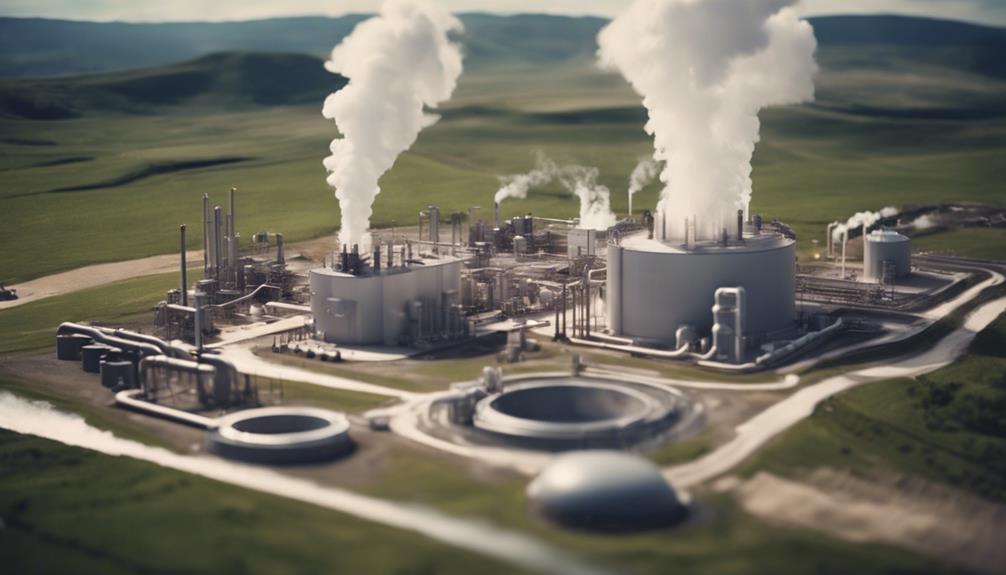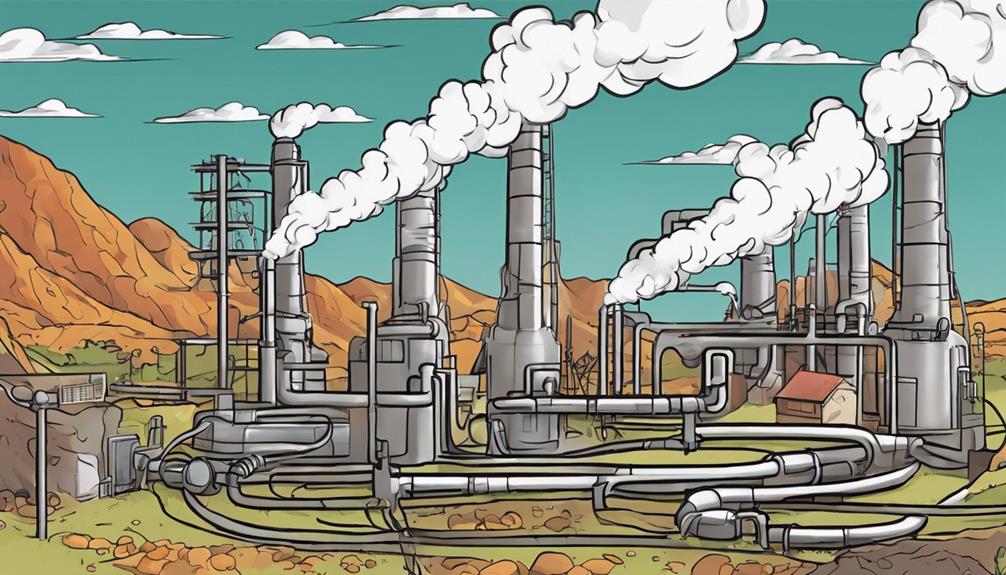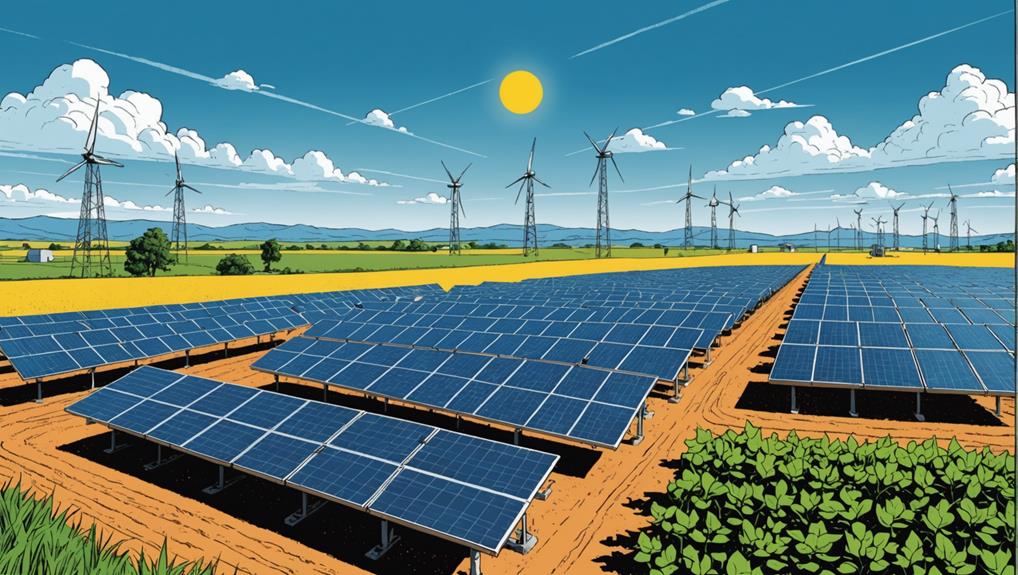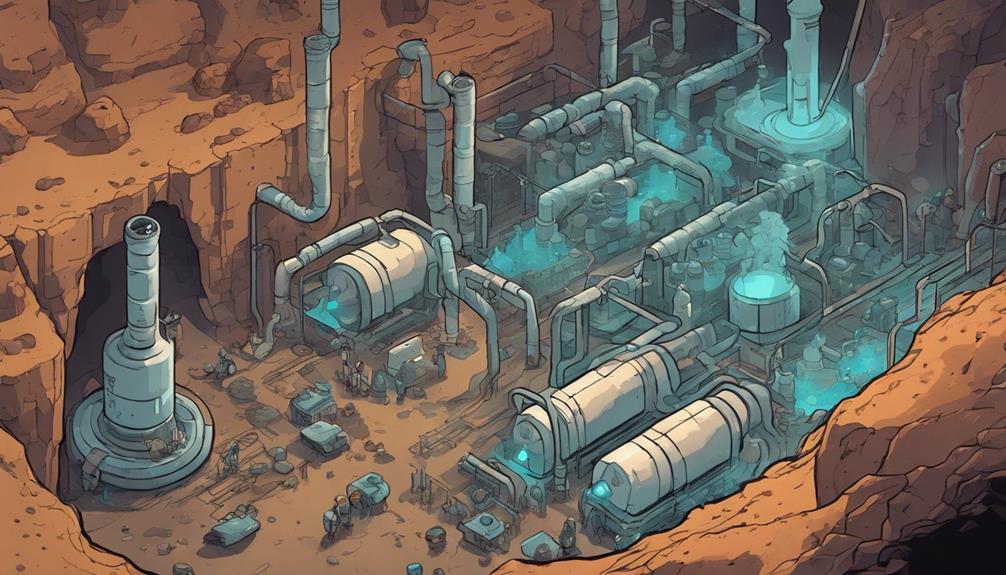Geothermal energy is turned into electricity in various ways. Dry steam plants directly convert underground steam into power, making it eco-friendly. Flash steam plants bring hot water to the surface, turning it into vapor to drive turbines. Binary-cycle plants efficiently generate electricity from lower temperature geothermal sources. These processes showcase the versatility of geothermal power production.
Key Takeaways
- Geothermal energy is transferred to electricity through steam or hot water.
- Steam drives turbines connected to generators for power production.
- Hot water can also be used to generate steam for turbine operation.
- Turbines convert steam pressure or kinetic energy into electricity.
- Efficient systems like dry steam, flash steam, or binary-cycle plants optimize geothermal energy conversion.
Geothermal Power Plants Overview
Geothermal power plants harness the Earth's heat to produce electricity through various technologies. In these plants, hot water is passed from underground reservoirs to the surface where it can be used to generate power.
There are three main types of geothermal power plants: dry steam, flash steam, and binary cycle. In a flash steam power plant, the hot water is transformed into vapor as it's released under lower pressure, driving turbines connected to a generator that produces electricity. This process allows for the conversion of geothermal energy into usable power.
The key component in this system is the heat exchanger, where the heat from the hot water is transferred to a secondary fluid, causing it to vaporize and power the turbine. Flash steam power plants play an essential role in the efficient utilization of geothermal resources for sustainable electricity generation.
Dry Steam Power Plant Process

Dry steam power plants are an essential part of geothermal energy production. They harness underground steam to directly generate electricity, making the process efficient and environmentally friendly.
This direct steam-to-electricity conversion process is a key feature of dry steam power plants.
Steam Power Generation Process
When considering steam power generation processes in geothermal energy production, a direct connection between underground steam resources and electricity generation is essential.
Dry steam power plants are at the forefront of this technology, utilizing underground steam to generate electricity efficiently and sustainably. These plants rely on the natural geothermal fluid, in the form of dry steam, to power turbines and produce electricity.
One notable example is the Larderello geothermal power plant in Italy, the world's oldest facility of its kind, which has been successfully generating electricity since 1904.
Similarly, the Geysers in northern California continue to showcase the effectiveness of dry steam power generation. By tapping into underground steam resources, dry steam power plants offer a reliable and environmentally friendly method of generating electricity, making the most of the Earth's natural heat reservoirs.
Direct Steam-To-Electricity Conversion
Utilizing underground steam resources, direct steam-to-electricity conversion in dry steam power plants drives generators to efficiently produce electricity.
In dry steam power plants, underground steam reservoirs are tapped into using wells, such as those at The Geysers in California. The steam, primarily in the form of hydrothermal fluids, is then directly piped to the power plant.
Once at the plant, the steam flows through turbines connected to generators. As the steam passes through the turbines, its energy is converted into mechanical energy, which in turn drives the generators to produce electricity.
This process of direct steam-to-electricity conversion allows for a relatively straightforward and efficient means of harnessing geothermal energy.
The oldest dry steam power plant, still in operation today, can be found in Larderello, Italy, and also at The Geysers in northern California.
Dry steam power plants play a significant role in sustainable electricity generation by utilizing the natural steam resources found underground.
Flash Steam Power Plant Operation

Operating a flash steam power plant involves bringing high-temperature hot water to the surface through wells. In this process, the geothermal energy contained in the hot water is utilized to generate electricity.
As the hot water is brought up, the drop in pressure causes it to rapidly transform into steam. This separated steam is then directed to drive a turbine, which is connected to a generator that produces electricity. The turbine converts the steam's energy into rotational motion, which in turn generates electrical power.
To ensure sustainability, any water that remains after this process is reinjected back into the geothermal reservoir.
Flash steam power plants are an efficient and widely used method of converting geothermal energy into electricity, making them a key player in the domain of sustainable energy production.
Binary-Cycle Power Plant Mechanism

Binary-cycle power plants are designed to efficiently generate electricity using lower temperature geothermal resources. In this mechanism, geothermal fluids don't directly interact with turbine units, ensuring a more controlled and sustainable operation.
The secondary fluid, which vaporizes in a heat exchanger, plays a key role in driving the turbines and producing power.
Binary-Cycle Operation Details
In the mechanism of a binary-cycle power plant, a secondary fluid efficiently facilitates the conversion of geothermal heat into electricity without direct contact with the turbine units. This process is critical for utilizing lower temperature geothermal resources to generate power.
The secondary fluid, which has a lower boiling point than water, passes through a heat exchanger where it flashes into vapor upon contact with the geothermal heat. The vapor produced then drives the turbines, ultimately generating electricity.
This innovative technology allows for the efficient deployment of geothermal electricity in areas with lower temperature resources, expanding the reach of geothermal energy as a sustainable power source.
Turbine Power Generation
To efficiently generate electricity in a binary-cycle power plant, the secondary fluid, with its lower boiling point, plays an essential role in driving the turbines without direct contact with the geothermal fluid. In this process, the geothermal fluid transfers its heat to the secondary fluid in a heat exchanger.
As the secondary fluid reaches its boiling point, it transforms into vapor, expanding and flowing through the turbines. The high-pressure vapor drives the turbine blades, converting the kinetic energy into mechanical energy that ultimately generates electricity.
By utilizing this binary cycle mechanism, power generation from geothermal sources becomes more versatile, allowing for the extraction of energy from lower temperature geothermal reservoirs that mightn't be suitable for direct power generation.
This innovative approach in turbine power generation has greatly contributed to the wider adoption and expansion of geothermal electricity production, making it a key player in the renewable energy landscape.
Enhanced Geothermal Systems (EGS) Benefits

Enhanced Geothermal Systems (EGS) bring substantial benefits to the energy industry by accessing deeper geothermal resources economically. With EGS technology, the potential for geothermal electricity production expands notably. The U.S. Geological Survey has estimated a vast 500,000 MW of EGS potential in the western U.S. This technology allows tapping into extensive geothermal energy reserves that were previously unreachable, thereby playing an essential role in increasing electricity generation through geothermal sources.
EGS offers a promising pathway to enhance geothermal electricity production by harnessing the heat from deep within the Earth's crust. By utilizing EGS, the energy industry can discover new opportunities for sustainable electricity generation. This method not only boosts the overall capacity for geothermal power but also helps in diversifying the energy mix towards cleaner sources.
Through the utilization of EGS technology, the energy sector can make notable strides in harnessing the full potential of geothermal resources for electricity generation.
Low-Temperature Resources Utilization

Utilizing low-temperature geothermal resources expands the potential for electricity generation in various locations. Here's how it works:
- Low-Temperature Geothermal Resources: These resources typically range from 225-360°F, making them suitable for electricity production through innovative methods.
- Binary-Cycle Power Plants: Specifically designed for low-temperature geothermal sources, these plants utilize secondary fluids to transfer heat from the geothermal fluid without direct contact, preventing mineral buildup and corrosion issues.
- Vapor Driven Turbines: By using secondary fluids that flash into vapor due to the geothermal heat, turbines are driven to generate electricity efficiently, even with lower temperature resources.
This approach not only allows for the sustainable utilization of low-temperature geothermal sources but also enables the expansion of geothermal electricity deployment to regions previously deemed unsuitable.
The use of secondary fluids in binary-cycle power plants showcases how advancements in technology make geothermal energy a viable option for electricity generation in various settings.
Co-Produced Resources Sustainability

Co-produced resources sustainability plays a crucial role in enhancing the environmental impact and longevity of geothermal energy production. By harnessing hot water and other resources from oil and gas wells, geothermal power plants can generate electricity using binary cycle technology. These resources, typically at temperatures below 300°F, are ideal for this purpose.
Not only does this method enable the production of power from low-temperature geothermal sources, but it also helps reduce greenhouse gas emissions and prolong the lifespan of existing oil and gas fields. The utilization of co-produced resources is essential for enhancing the sustainability of geothermal energy production.
Frequently Asked Questions
How Is Geothermal Energy Converted Into Electricity?
To convert geothermal energy into electricity, you tap into underground reservoirs for hot water or steam. This energy spins turbines connected to generators in geothermal power plants, producing clean and sustainable electricity for various uses.
How Is Geothermal Power Transported?
To transport geothermal power, wells drilled deep underground bring hot water or steam to the surface. This high-pressure fluid drives turbines connected to generators, producing electricity. The power then flows through lines to supply homes, businesses, and the grid.
Can Geothermal Energy Be Transferred?
Yes, geothermal energy can be effectively transferred into electricity through geothermal power plants. By harnessing heat from underground sources, hot water or steam drives turbines to generate electricity in various geothermal power plant technologies.
How Does Geothermal Energy Produce Electricity Step by Step?
To produce electricity step by step, start by drawing hot water or steam from underground reservoirs. Use it to spin a turbine connected to a generator, converting kinetic energy into electrical energy. There are various methods to achieve this in geothermal power plants.
Can You Explain Geothermal Energy in a Simple Way for Kids to Understand?
Geothermal energy for kids is heat from the earth used to generate electricity. It comes from the Earth’s core where temperatures are extremely high. This energy can be harnessed through power plants and used to heat buildings. It is a clean and renewable source of energy.
Conclusion
So, now you know how geothermal energy is transformed into electricity. It's pretty cool, right?
Did you know that geothermal power plants can generate electricity 24/7, providing a reliable source of renewable energy? Pretty impressive, huh?
Keep learning about the amazing ways we can harness the Earth's natural resources to power our world sustainably.










